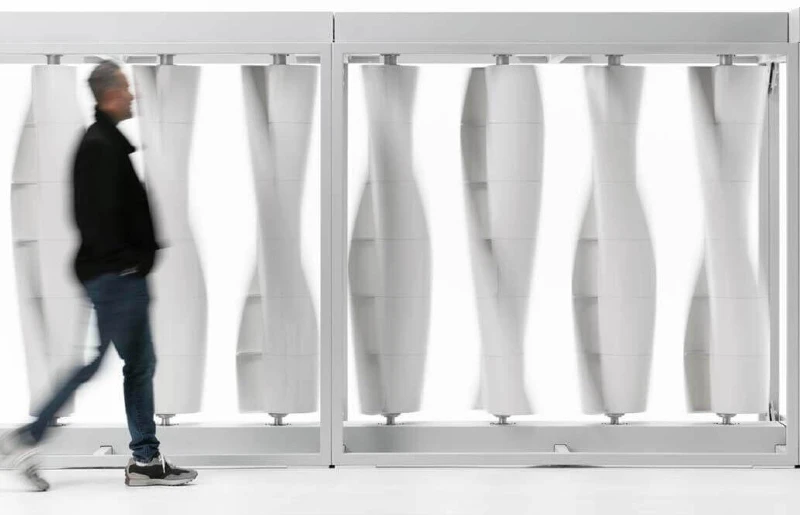In a quest to bring clean energy production to the heart of urban landscapes, New York-based designer Joe Doucet unveiled a unique take on wind energy: the Wind Fence. This innovative solution, made up of vertical wind turbines, creates energy while seamlessly blending into the architectural aesthetics of hotels, corporate buildings, and residential units.
Renewable energy, particularly wind energy, has long been part of the global shift away from fossil fuels. However, traditional wind turbine installations have primarily been large-scale endeavors, hindering their integration into distributed energy generation akin to rooftop solar panels. And they have downsides, which we’ve written about many times. In fact, wind energy isn’t the safest form of energy creation.
Doucet’s journey towards the Wind Fence began in 2021 when he identified a lack of efficient and visually appealing distributed energy products for wind power. Determined to bridge this gap, he embarked on designing a solution that marries efficiency with aesthetics.
The Birth Of The Wind Turbine Wall
Doucet’s initial concept, the Wind Turbine Wall, has undergone two years of refinement, focusing primarily on optimizing blade shape and size. Collaborating with Airiva, a company he co-founded with energy industry veteran Jeff Stone, Doucet subjected 16 vertical turbine blade designs to rigorous testing. When the testing was complete, the team had three final versions for wind tunnel trials.
After extensive testing across two US facilities, they identified the helical blade structure as the most efficient.
The concept itself isn’t groundbreaking. Airiva’s innovation lies in maximizing the energy produced through the simultaneous operation of multiple blades.

The Full Power of Wind
In its standard configuration, featuring eight precisely arranged helical blades, the Wind Fence has an annual energy output of approximately 2,200 kilowatts.
The average US household uses 10,649 kilowatt-hours of electricity annually, so the wind fence won’t suffice for individual homes. But it will help, and it certainly presents a compelling proposition for corporations, public institutions, and real estate firms seeking sustainable energy solutions.
Before you decide to buy five Wind Fences for your home and remove yourself from the grid entirely, you should be aware of the dimensions. Each unit measures around 14 feet (4.2 meters) by seven feet (2.1 meters).
The Wind Fence’s primary allure is its silent operation, as well as its role as a statement piece for organizations committed to environmental stewardship. It’s expected to be less expensive to install and maintain than a traditional wind power generator turbine.
Airiva is also committed to sustainable manufacturing by promising to include 80 percent recycled materials into its production.
What Could It Power? Let’s Look At Some Examples
The 2,200 kilowatts annual output generated by the Wind Fence can power various aspects of everyday life for individuals, households, and businesses. Here are some examples (we did the math for you):
- Household Electricity Consumption: The average American household consumes approximately 10,649 kilowatt-hours (kWh) of electricity annually, according to the U.S. Energy Information Administration. The 2,200 kilowatts produced by the Wind Fence could meet a significant portion of this consumption, powering essentials such as lighting, appliances, and electronics.
- Electric Vehicle Charging: With the rising popularity of electric vehicles (EVs), the Wind Fence’s output could be used to charge EVs, reducing reliance on fossil fuels for transportation. Depending on the model, a single EV typically requires between 2,000 to 3,000 kWh of electricity per year for charging.
- Small Businesses: Many small businesses operate within a similar energy consumption range as households. The 2,200 kilowatts could support the energy needs of small offices, retail stores, or cafés, powering lighting, HVAC systems, computers, and other equipment.
- Community Facilities: The energy generated by the Wind Fence could also be directed towards powering community facilities such as schools, libraries, or recreational centers, particularly in times of electric grid disruption or power outages. These institutions often serve as hubs of activity and require a steady supply of electricity for lighting, heating, cooling, and electronic devices.
- Water Heating: A significant portion of household energy consumption is attributed to water heating. The 2,200 kilowatts could be utilized to power electric water heaters, contributing to hot water production for bathing, cooking, and cleaning purposes.
- Street Lighting: Municipalities can utilize the Wind Fence’s output to power streetlights, enhancing visibility and safety in urban and suburban areas. LED streetlights, which are energy-efficient, can be powered by the renewable energy generated by the Wind Fence.
A Modular Solution for Sustainable Growth
More To Discover
- UN Report Reveals World Falling Drastically Short on Climate Goals, Warns of Looming Catastrophe
- Hawaii Bids Farewell to Coal, Embraces Future with Massive Battery Storage System (Powered by Oil)
- Wood Dust Solution Traps up to 99.9% of Microplastics in Water, A Potential Game-Changer Against Pollution
- LEGO-Like Concrete Blocks Made from Waste Could Reinvent Construction
The versatility of the Wind Fence extends beyond individual units, offering scalability through modular installations. Facilities can augment energy production by deploying arrays of units, leveraging the advantages of distributed energy systems, including reduced transmission losses and enhanced energy efficiency.
While the Wind Fence doesn’t rival the output of massive horizontal turbines, Airiva is focused on practical energy solutions. With custom pilots slated for later this year and commercial orders expected by 2025, the journey towards a greener future powered by the Wind Fence is well underway.




















